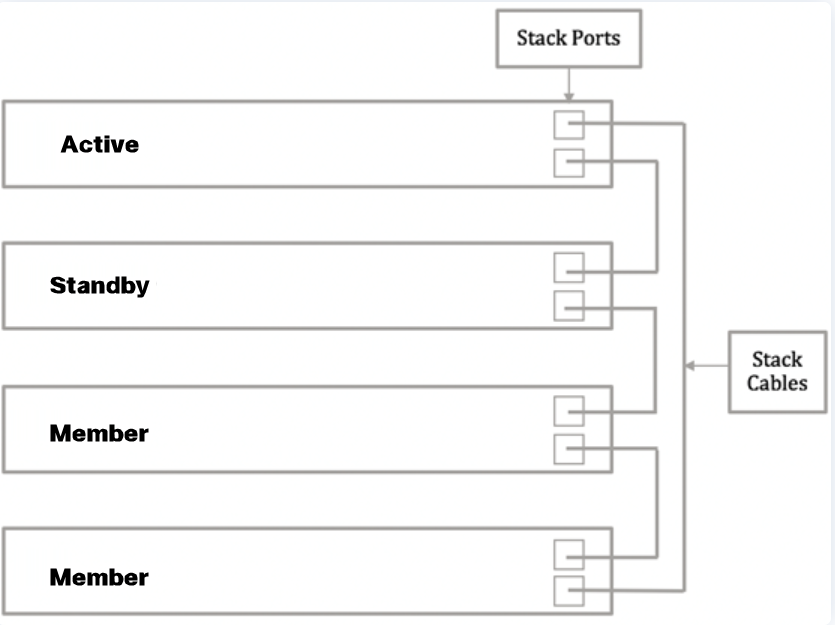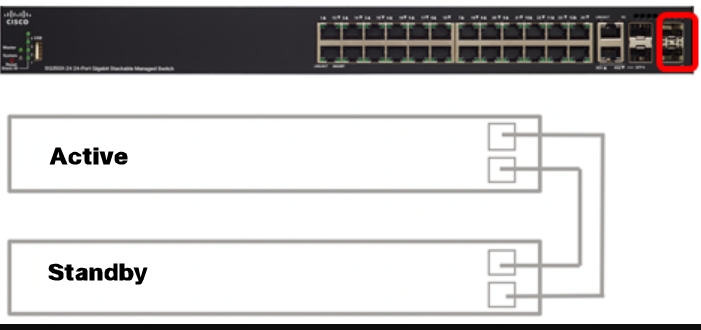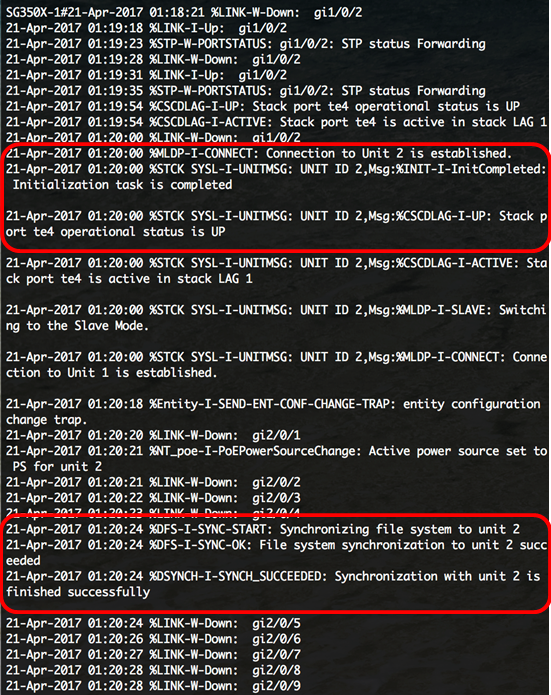Configure Stack Settings on a Switch through the CLI
Available Languages
Objective
Stacking allows you to expand your network capacity without the hassle of managing multiple devices. Stackable switches can be added or removed from a stack as needed without affecting the overall performance of the stack. Depending on its topology, a stack can continue to transfer data even if a link or unit within the stack fails. This makes stacking an effective, flexible, and scalable solution to expand network capacity.
By default, a switch is always stackable, but has no port configured as a stack port. All the ports in the devices are configured as network ports by default. A device without any stack port can be thought of as the active device in a stack of only itself or as a standalone device. To stack two or more switches, you can reconfigure the desired network ports as stack ports in the switches and connect them with the resulting stack ports in a ring or chain topology.
The units or switches in a stack are connected through stack ports. Stacked switches are then collectively managed as a single logical device. In some cases, stack ports can become members in a stack of Link Aggregation Groups (LAGs) increasing the bandwidth of the stack interfaces.
Some of these stacking terms may be unfamiliar to you. For further explanation, check out Cisco Business: Glossary of New Terms.
A stack provides the following benefits:
- Network capacity can be expanded or reduced dynamically. By adding a unit, the administrator can dynamically increase the number of ports in the stack while maintaining a single point of management. Similarly, units can be removed to decrease network capacity.
- The stacked system supports redundancy in the following ways:
- The Standby unit becomes the active of the stack if the original active fails.
- The stack system supports two types of topologies: Chain and Ring. Ring topology is more reliable than a chain topology. The failure of one link in a ring does not affect the function of the stack, whereas the failure of one link in a chain connection might cause the stack to be split.
This article provides instructions on how to configure stack settings through the Command Line Interface (CLI) of your switch.
Applicable Devices | Firmware Version
- Sx350 | 2.2.8.4 (Download latest)
- SG350X | 2.2.8.4 (Download latest)
- Sx500 | 1.4.7.05 (Download latest)
- Sx550X | 2.2.8.4 (Download latest)
Configure Stack Settings on a Switch
Connect the Switches
Step 1. Determine the stack mode that you would want to configure. The options are:
- Chain - Each unit is connected to the neighboring unit, but there is no cable connection between the first and last unit. This is the default stack mode. The image below shows a chain topology of a four-unit stack:

- Ring - Each unit is connected to the neighboring unit. The last unit is connected to the first unit. The image below shows a ring topology of a four-unit stack:

Step 2. Connect one end of the Small Form-Factor Pluggable (SFP) cable that came with your device into the SFP+, XG3, or XG4 port of your switch.

Note: In this example, the cable is connected to XG3 port of the switch.

Step 3. Connect the other end of the SFP+ cable into the SFP+, XG3 or XG4 port of your switch.

Step 4. Repeat Steps 2 to 3 to the remaining switches.
In this scenario, two switches are being configured for stacking and the SFP cables are connected to ports 3 and 4 on both switches.

You should now have connected your switches according to your desired topology.
Configure Stack Settings on the Active Switch
Active Switch Selection Process
The active unit is selected from the active-enabled units (1 or 2). The factors in selecting the active unit are taken into account in the following priority:
- System Up Time - The active-enabled units exchange up-time, which is measured in segments of 10 minutes. The unit with the higher number of segments is selected. If both units have the same number of time segments, and the unit ID of one of the units was set manually while the unit ID of the other was set automatically, the unit with the manually-defined unit ID is selected; otherwise the unit with the lowest unit ID is selected. If both units IDs are the same, the unit with the lowest Media Access Control (MAC) address is chosen.
- Unit ID - If both units have the same number of time segments, the unit with the lowest unit ID is selected.
- MAC Address - If both units IDs are the same, the unit with the lowest MAC address is chosen.
Follow these steps to configure stack settings on the Active switch:
Step 1. Log in to the console of the first switch. The default username and password is cisco/cisco. If you have configured a new username or password, enter the credentials instead.

Step 2. Enter the Global Configuration mode of the switch by entering the following:
SG350X-1#configureStep 3. To enter the context of the specified stack unit or all stack units, enter the stack unit command in the Global Configuration mode by entering the following:
SG350X-1(config)#stack unit [unit-id | all]
Step 4. Enter the stack configuration command to configure the stack ports and unit ID after reboot by entering the following:
SG350X-1(unit)#stack configuration {[links ports-list] [unit-id | auto]}The options are:
- ports-list - a list of one or more stack ports separated by comma, or a range of sequential ports marked by dash.
- links - Choose port list to be used as stack links after reload.
- unit-id - Choose the unit ID to be used after reload. The range is 1 to 4. You can use auto to enable stack auto numbering feature.

Step 5. (Optional) To remove stack configuration settings on the switch, use the no stack configuration command by entering the following:
SG350X-1(unit)#no stack configurationStep 6. Enter the end command to go back to the Privileged EXEC mode of the switch.
SG350X-1(unit)#end
Step 7. (Optional) To display the stack configuration settings, enter the following:
SG350X-1#show stack configuration
Step 8. (Optional) In the Privileged EXEC mode of the switch, save the configured settings to the startup configuration file, by entering the following:
SG350X-1#copy running-config startup-config
Step 9. (Optional) Press Y for Yes or N for No on your keyboard once the Overwrite file [startup-config]… prompt appears.

Step 10. Reload the switch to apply the configured stack settings by entering the following:
SG350X-1#reload
Important: When a switch is reloaded, the running configuration file is deleted. Before proceeding with the reload instructions, make sure to save all the running configuration settings to avoid data loss.
Step 11. Press Y for Yes or N for No on your keyboard once the Do you want to continue prompt appears.

The Active unit will now reboot. You should now have configured the stack settings of your active unit.
Configure Stack Settings on the Standby or Member Switch
Step 1. Log in to the console of the second switch. The default username and password is cisco/cisco. If you have configured a new username or password, enter the credentials instead.

Step 2. Enter the Global Configuration mode of the switch by entering the following:
SG350X-2#configureStep 3. To enter the context of the specified stack unit or all stack units, enter the stack unit command in the Global Configuration mode by entering the following:
SG350X-2(config)#stack unit [unit-id | all]
Step 4. Enter the stack configuration command to configure the stack ports and unit ID after reboot by entering the following:
SG350X-2(unit)#stack configuration {[links ports-list] [unit-id | auto]}The options are:
- ports-list - a list of one or more stack ports separated by comma, or a range of sequential ports marked by dash.
- Links - Choose port list to be used as stack links after reload.
- unit-id - Choose the unit ID to be used after reload. The range is 1 to 4. You can use auto to enable stack auto numbering feature.

Step 5. (Optional) To remove stack configuration settings on the switch, use the no stack configuration command by entering the following:
SG350X-2(unit)#no stack configurationStep 6. Enter the end command to go back to the Privileged EXEC mode of the switch.
SG350X-2(unit)#end
Step 7. (Optional) To display the stack configuration settings, enter the following:
SG350X-2#show stack configuration
Step 8. (Optional) In the Privileged EXEC mode of the switch, save the configured settings to the startup configuration file, by entering the following:
SG350X-2#copy running-config startup-config
Step 9. (Optional) Press Y for Yes or N for No on your keyboard once the Overwrite file [startup-config]… prompt appears.

Step 10. Reload the switch to apply the configured stack settings by entering the following:
SG350X-2#reload
Important: When a switch is reloaded, the running configuration file is deleted. Before proceeding with the reload instructions, make sure to save all the running configuration settings to avoid data loss.
Step 11. Press Y for Yes or N for No on your keyboard once the Do you want to continue prompt appears.

After the switch reboots, the Standby switch will no longer be a standalone device and will only be accessible through the active switch.
Step 12. Repeat steps 1 to 11 for the configuration of the member switch or switches.
You should now have configured the stack settings on your Standby and/or member switches.
Show Stack Configuration Settings on the Switch
Step 1. Log back in to the console of the Active unit.

Quick Tip: Access the Active unit while configuring the Standby and/or Member switches to monitor the progress. Once the Standby or Member switch reboots, the active switch will be notified with the stacking activities.

Step 2. In the Privileged EXEC mode of the switch, use the show stack command to show the stack settings on the switch by entering the following:
SG350X-1#show stack
Step 3. Enter the show stack links command to show the stack links on the switch by entering the following:
SG350X-1#show stack links [details]The options are:
- stack links - Displays the stack links information for an entire stack.

- stack links details - Displays the stack links information for an entire stack with details.

Step 4. (Optional) To access the Standby switch, enter the stack unit ID of the switch in the Global Configuration context by entering the following:

You should now have configured the stack settings on your switches.
Revision History
| Revision | Publish Date | Comments |
|---|---|---|
1.0 |
13-Dec-2018 |
Initial Release |
 Feedback
Feedback